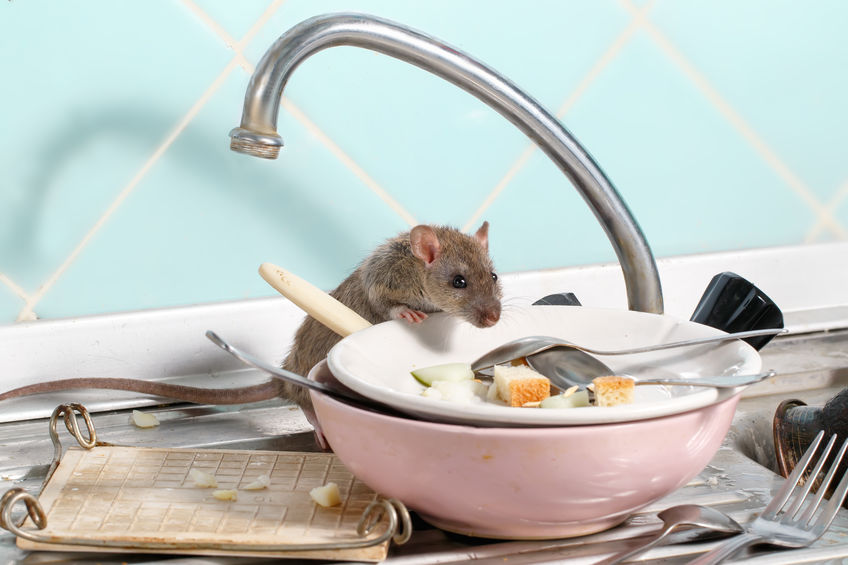
An irrational fear of rats and mice is a very common phobia (murophobia or musophobia in case you were wondering). Even if you are not scared witless by rats or mice, you probably don’t want them scurrying around your food cupboards or playing in your bedroom at night. And nor do your tenants, as rodents spread serious diseases.
In this guide, with the help of Jordan Foster of Fantastic Pest Control Services we are going to look at the problem of rats and mice in rental properties, signs to look out for, who’s at fault, and how you can tackle the problem.
Contents
- Know thy enemy
- How quickly do rats and mice breed?
- Health problems caused by rats and mice
- Signs a property is infested with rats
- Signs a property is infested with mice
- How the Pandemic Affects Rat Populations
- The dangers of not dealing with an infestation
- Who is at fault for a rodent infestation?
- What does the law say about rodent infestations?
- Problems caused by tenants
- Show some empathy
- Working with tenants to eliminate the problem
- Working with your local environmental health department
- Eradicating rodents from a rental property
- Calling in the Experts
- Does landlord insurance cover rodent infestations?
- How to prevent a rodent infestation
- Be a pet-friendly landlord
- What NOT to do
Know thy Enemy
Before we get on to the thorny problem of how to eradicate rats and mice from your rental property, it’s essential that you educate yourself on the nature of your enemy.
As Sun Tzu says in The Art of War:
“If you know the enemy and know yourself, you need not fear the result of a hundred battles.”
How Quickly do Rats and Mice Breed?
Visit any continent in the world and you’ll find rats and mice in abundance. Both species have adapted to living with humans, thanks to the volume of food waste we discard and the loss of their natural environment.
A female rat can produce around 72 babies a year. Females reach maturity in five weeks, so it’s not difficult to visualise how quickly a rat population grows when food and shelter are readily available.
Mice are also prolific breeders, so once a pair of mice move into your rental property, it won’t be long before they are running rampant. Outdoors, mice are prey animals and there are many natural predators eager for a mouse snack, but indoors, mice are well protected and will breed with impunity. Like rats, mice breed all year round and are ready to make babies at five weeks.
Health Problems Caused by Rats and Mice
People can catch diseases from rodents in many ways:
- Direct contact with rodent urine, faeces, saliva, blood, and dead rodents
- Ingesting food contaminated with all of the above
- Inhaling air contaminated with rodent urine and faeces
- Drinking water contaminated with rodent urine and faeces
- Bites and scratches from rodents
Rodents are also disease vectors. They carry fleas, which can bite humans – this was believed to be how the Bubonic Plague spread to Europe in the 1600s, although most experts now believe the main method of transmission was human fleas and lice. Still, rats and their fleas are not entirely blameless!
And finally, household pets may eat rats and mice with intestinal worms, which can spread to humans because of poor hygiene.
Plague and Other Diseases Spread by Rats and Mice
The ‘black death’ is the most famous of the 35 diseases spread by rats, but it isn’t the only one. The following are all serious diseases that can cause illness and even death if left untreated.
- Weil’s Disease
- Salmonellosis
- Leptospirosis
- Toxoplasmosis
- Rat bite fever
Others include hantavirus, Lassa fever, Tularemia, and Echinococcosis.
Signs a Property is Infested With Rats
In warm weather, rats are most often found outdoors, but as the weather gets colder and food becomes scarce, they will go in search of warm places to nest and a regular food supply. Unfortunately, if there are easy access points, this could mean your rental property.
Rats are nocturnal (awake in the night and sleep through the day), so unless there is a huge infestation, you won’t see them during the day. But there are plenty of signs Mr Ratty and his extended family have moved into your rental property without signing a tenancy agreement.
Look for signs of rats in the roof space if the tenant has reported strange noises at night. Rats also like to make their nest in the kitchen. They particularly like gaps behind cupboards and ovens, as food is in close proximity and it’s usually nice and warm for rat babies.
Outdoors, rats may be found under sheds, in garages, and other outbuildings; they can burrow anywhere.
Rat droppings are the most common sign to look out for. Anywhere rats have been, there will be trails of rat poo. Their droppings are small and look a bit like large brown rice grains. Large numbers of rat droppings in one place indicate the main nest is nearby.
Rats chew everything and anything to keep their teeth worn down. Gnaw marks on skirting boards, walls, electrical wiring, plastic food containers, and anything else in and around the property is a reason to be suspicious. Rats also chew things to make a nest for their babies, such as roof insulation, carpet, and wood.
If the property has been vacant for a while, look for rat footprints in the dust.
Rats travel along well-worn trails inside and outdoors, usually along fences and walls. Look out for grease tracks along walls, floors, and even low ceilings in an attic space.
If the tenant has cats or dogs, dead rats might be deposited in and around the property, and where there’s one dead rat visible, you can guarantee it has plenty of relatives somewhere nearby.
Signs a Property is Infested With Mice
Signs of a mice infestation are very similar to those of a rat problem. If mice are in residence, look for numerous small, dark droppings in cupboards and along skirting boards. Mice also leave grease trails, make nests in small spaces and scratching noises at night.
Strange electrical problems are a common sign of a mice infestation – mice love to chew electrical wiring and will often chew through cables and cause power cuts.
One distinctive sign of a mouse problem is the smell. Mice pee a lot and a strong smell of ammonia is indicative of mice in residence. Look for ‘urine pillars’, which are small mounds of mouse urine mixed with grease and dirt. These are most unpleasant but a good sign you have mice in the property.
Mice usually live in the fabric of the building. They exist in roof spaces, in cavity walls, and under floors, only emerging to look for food. Unlike rats, mice don’t usually venture outside, as there are too many predators. Instead, they use structural defects such as holes where pipes pass through walls and floorboards, to move between different spaces. The more food there is available, the larger the mouse population the property can support.
How the Pandemic Affects Rat Populations
Rats have an excellent scent and can follow the aroma of a fresh food source located far away. As rodents, they can stand hunger and will do anything to get fed. Travelling from one part of town to another is not an issue.
The hunger will make rats more vulnerable than ever. Because of their migration, they will end up in a new territory, that they don’t know as well. So they will be vulnerable before setting up nests and finding safe pathways to the food source and back.
A hungry rat is more likely to fall for a baited trap. Rodents are usually very suspicious of new items in their habitat, but in this case, the whole habitat is new. The urge to chew on something is also putting pressure on them and they will go for the bait.
Do not store food in anything different than metal containers.
Use rodent-proof door sweeps-It’s a great tool that will seal the gap between the doorstep and the door. A rat or a mouse can squeeze through any tiny hole it can get its head through. Their bones are very flexible and their bodies are kind of melting through the gap, it’s a bit shocking when you see it for the first time but it’s real.
Use ultrasonic rat repellents these can be an effective way to keep rodents at bay at least until you can hire a professional pest exterminator.
What you should know is that a fully domesticated animal might get afraid from a rat of very large size. A wild rodent may also transmit a large number of diseases if it bites your pet, so you should regularly check your pet for signs of a rat bite.
But can Rats Transmit COVID-19?
There are no proven cases of COVID-19 sick rats, let alone rodents that transmitted the disease to a human, or other rodents.
Moreover, if we can transmit the virus on our fingertips, it would be possible for rats to transmit it on their fur, paws and tails. Those rodents are inhabiting our sewer lines, so it is safe to say that they don’t have a great level of personal hygiene. Rats are no joke, it is imperative that you seek professional rat control help or take actions yourself at the first signs or suspicions of rats.
The UK Secretary of State for Environment, Food and Rural Affairs, mister George Eustice confirmed pest control as an essential service during the pandemic. As a property owner, it is your duty to keep a close eye for any signs of pests and deal with them as soon as possible, not letting an infestation to develop and spread around.
The Dangers of not Dealing With an Infestation
Not dealing with a rodent infestation can have long-term consequences.
Rats and mice can cause significant damage to electrical wiring, floorboards (and other timber), roof insulation, and even plasterboard walls. The longer you ignore the problem, the more it will cost to repair the mess.
Tenants won’t want to stay in a property infested with rodents. Would you? If you don’t address the problem, they will most likely hand in their notice and move out, leaving you with a vacant property that’s difficult to fill. You are then potentially stuck paying a mortgage with no income to cover the expense.
A failure to deal with a rodent infestation also leaves you open to prosecution by your local housing department.
Who is at Fault for a Rodent Infestation?
If a property is infested with vermin before a tenant moves in or the property has structural defects that allow rodents to gain access, it is the landlord’s responsibility to deal with the problem.
The tenant may be at fault if the problem has arisen during their tenure (and it isn’t caused by structural defects due to a failure by the landlord). For example, if a tenant has made holes in the wall to run cables into the property and leaves rubbish lying around, it could arguably be their fault if rats subsequently move in. The landlord must prove there was not an issue at the start of the tenancy.
A standard shorthold tenancy agreement may have a clause that states tenants are responsible for the cost of dealing with vermin. If the problem is caused by the landlord, this clause is not enforceable.
What Does the Law say About Rodent Infestations?
While there is no legislation that specifically says landlords are responsible for the eradication of vermin in a rental property, the law is clear on one thing: landlords have a legal responsibility to ensure their properties are habitable, which in a civilised society, means free from rodents. As a landlord, you must take reasonable steps to deal with a rodent problem.
Homes (Fitness for Human Habitation) Act 2018
Landlords are contractually obliged to provide rental housing that is fit for human habitation. The Homes (Fitness for Human Habitation) Act 2018 came into force to ensure homes in the private rental sector were free from anything that could cause serious harm. This includes vermin.
If a landlord fails to put right health and safety issues (a vermin infestation falls into this category), they can be prosecuted by the tenant or local authority. The Homes (Fitness for Human Habitation) Act 2018 applies to any tenancy with a fixed term of less than seven years.
Housing Act 2004
The Housing Act 2004 established the Housing Health and Safety Rating System (HHSRS). Section C Protection against infection covers domestic hygiene, pests, and refuse.
DOMESTIC HYGIENE, PESTS AND REFUSE
This is concerned with protection against infection. Includes hazards resulting from:
- Poor design/layout/construction of the dwelling so that it is difficult to be kept clean and hygienic;
- Access into and harbourage within the dwelling for pests; and
- Inadequate and unhygienic provision for storage and disposal of household waste.
Note: hazards connected with sanitation and drainage, domestic water, personal washing facilities and food safety are considered in other profiles.
Health effects
These can include gastro-intestinal disease (from spread of infection), asthma and other allergic reactions (from allergens), stress (because of difficulties in keeping the home clean and from accumulations of refuse) food spoilage from insect infestation (e.g. cockroaches), infections (spread by insects and rats and mice) and nuisance.
Local authority housing inspectors can use the HHSRS to make a judgement as to how serious the problem is, and whether remedial action needs to be taken. The HHSRS can be used as the basis for enforcement action, although this is rare.
Landlord and Tenant Act 1985
There is an implied obligation in the Landlord and Tenant Act 1985 that states the landlord must maintain the structure of the building. This includes drains and external pipes, a common entry point for vermin.
Repairing obligations in short leases.
(1) In a lease to which this section applies (as to which, see sections 13 and 14) there is implied a covenant by the lessor—
(a) to keep in repair the structure and exterior of the dwelling-house (including drains, gutters and external pipes),
(b) to keep in repair and proper working order the installations in the dwelling-house for the supply of water, gas and electricity and for sanitation (including basins, sinks, baths and sanitary conveniences, but not other fixtures, fittings and appliances for making use of the supply of water, gas or electricity), and
(c) to keep in repair and proper working order the installations in the dwelling-house for space heating and heating water.
Environmental Protection Act 1990
A vermin infestation could be regarded as a statutory nuisance under the Environmental Protection Act 1990. If action is not taken by the landlord, the local authority has the power to enter the premises to inspect, enforce, and carry out treatment works, with only 24 hours’ notice. If the problem is caused by a failure of the landlord to meet their contractual repair obligations, the local authority can prosecute them.
The Prevention of Damage by Pests 1949
Part 1, Section 3 of The Prevention of Damage by Pests 1949 states that the local authority can take steps to address a rodent problem. The authority can recover any expenses reasonably incurred whilst doing so if the person served with an enforcement notice doesn’t carry out improvements by the time recorded in the notice.
Remedies for failure to comply with notice under s. 4.
(1) Subject to the provisions of the last foregoing section with respect to appeals, if any person on whom a notice is served by the local authority under that section fails to take any steps required by the notice at the time or within the period prescribed by the notice, the local authority may themselves take those steps and recover from him any expenses reasonably incurred by them in doing so.
Case law: Read v Notting Hill Housing Trust Bow County Court, 2013
Within a few months of moving into a ground floor flat, the tenant notified the landlord and the local council’s environmental health department about a rat problem. He stated rats were getting into the property via holes in the floor. The flat had other problems, too, including a faulty boiler and rising damp. The tenant was offered alternative accommodation after a year, but one child had already decamped to a grandmother’s house because of the rat infestation. The matter ended up in court and the tenant was awarded total damages of £14,825.
Problems Caused by Tenants
Assured shorthold tenancy agreements state that a landlord is contractually obliged to maintain a rental property so that it is fit for human habitation. The structure must be in a good state of repair and there must be no vermin residing there, but tenants may bear some responsibility too. Whilst a landlord has a duty of care to ensure there are no holes where vermin can get in and there are suitable bins provided for rubbish collection, the tenant also has to do their bit.
Landlords can only do so much to prevent vermin from infesting a property. Tenants also have a contractual obligation to dispose of waste correctly, keep their rental property clean, and store food in appropriate containers.
Show Some Empathy
Irrespective of whose fault a vermin infestation is, show some empathy for your tenants. You may not see mice as especially scary, but some people are absolutely petrified of rodents and will rightly refuse to live in a property infested with critters.
Do not delay if your tenants report a vermin infestation. Visit the property as soon as possible and look for the root of the problem. Look for maintenance issues, such as holes in the floor or open drains, and fix them as soon as possible. Fixing structural defects is the only long-term way to eradicate vermin.
Working With Tenants to Eliminate the Problem
If your tenant reports a vermin problem or you receive an enforcement notice from the local authority, you need to talk to your tenants as soon as possible. Visit the property to verify what’s happened and why.
If the issue has arisen as a result of structural defects fix these immediately and explain to the tenant what the next steps are. If your tenants are at fault you should remind them of their contractual obligations and educate them on how to keep the property clean and free of anything that may be attracting vermin.
Working With Your Local Environmental Health Department
Under Part 1, Section3 of The Prevention of Damage by Pests 1949, Landlords have an obligation to inform their local environmental health department if a tenant reports substantial numbers of rats on their land or in their property.
Obligation of occupiers of land to notify local authority of rats and mice.
(1) Subject to the provisions of this section, the occupier of any land shall give to the local authority forthwith notice in writing if it comes to his knowledge that rats or mice are living on or resorting to the land in substantial numbers.
Even if there aren’t hundreds of rats roaming around chomping on discarded pizza crust, once a tenant reports a vermin infestation, it is sensible to call your local environmental health department to try and work out the origin of the problem.
An environmental health officer should be able to determine if the infestation is a symptom of a wider problem in the local area. It may also be caused by an act or omission by the tenant or landlord. They can also offer specific advice on how to deal with the problem.
Eradicating Rodents From a Rental Property
Unless the rodent problem is significant, you may be able to tackle it using DIY methods. The first step is to eliminate all entry points into the property. Rats and mice can squeeze through very small gaps, and in the case of mice, if you can fit a pencil in the opening, a mouse can push through.
Pay close attention to gaps where pipes come through the wall. Fill small gaps with caulking and mortar – a mix of steel wool and mortar will keep rats out of larger openings. Seal gaps around windows and doors and look for openings in the eaves of the roof, which are common in older properties.
Old-fashioned Mouse Traps baited with peanut butter are useful if the problem is mouse-related or you’re not sure there even is a problem. Set traps in strategic areas around the house, such as in the attic or a pantry. Mice are curious and will usually take the bait within a day. If you catch one mouse, then you can assume there are many more hiding away out of sight. Note that it can be upsetting for tenants to find mouse corpses in a trap.
Spring-loaded rat traps can be used to catch and kill rats outside, but they are not for the faint-hearted. There are also rat trap cages, which don’t kill the rat, but this means someone has to then humanely do the deed or relocate an angry rat to a new location.
Poison bait is another common strategy for killing both mice and rats, but it isn’t advisable to use poison traps when there is a danger pets or children might come into contact with the bait. Vermin poison is just as lethal to other small animals and your tenant will never forgive you if their cat dies after eating rat poison.
Note that many domestic anticoagulant rodenticides are no longer effective against rats and mice. Due to incorrect use of such products, rodents have built up resistance to the chemicals they contain.
Bear in mind that if you use rat or mouse poison the animal won’t die immediately. Instead, it will go and die somewhere else, and if the final resting place happens to be in a cavity wall or under the floorboards, your tenants can look forward to a deeply unpleasant aroma for many weeks while the corpse decomposes.
Always dispose of dead rodents safely. Leaving a poisoned rat out in the open could inadvertently lead to the death of other animals and birds that scavenge on the rat’s carcass. The BPCA recommends that dead rodents are double-bagged and placed in the general waste bin. It is best to check with your local council first, as there may be restrictions on dumping dead animals in the household waste. Another option is to ask a local pest control firm to remove the carcass.
Calling in the Experts
The best way to deal with a vermin infestation is to call in the experts. They have tools and rodenticides not available in your local DIY store. They’ll use a range of methods to monitor the size of the infestation, identify where the nest is located, and come up with a strategy to deal with the problem in the shortest possible time frame.
Adopting a professional approach to a rodent infestation is more likely to inspire goodwill in your tenants, which is important if you don’t want your landlord brand damaged.
Look for a pest control company that is a member of the British Pest Control Association (BPCA). This gives you peace of mind that the pest control company is insured, fully trained, and trustworthy.
Bear in mind that it may take several visits before a rodent problem is truly eradicated. Rats are naturally wary of new objects placed in their environment.
Does Landlord Insurance Cover Rodent Infestations?
Read the terms and conditions of your landlord insurance to see if rodent infestations are covered. Landlord emergency policies often feature comprehensive protection that covers pest infestations, including vermin.
Even if you can’t claim for the cost of calling in a professional pest control company, you may be able to claim for any damage caused by rats or mice, such as chewed electrical cables or gnawed timber.
How to Prevent a Rodent Infestation
Preventing a problem from occurring in the first place is always better than calling out an expensive pest control company.
- Fill in gaps around pipes and vents
- Check outbuildings for access points
- Cover open drains and block off unused pipes and drains
- Keep gardens tidy and cut back overgrown shrubs and hedges
- Be wary of storing piles of wood
- Don’t allow debris and rubbish to accumulate
- If tenants feed the garden birds, ask them to use a bird table or feeder and not to leave food out overnight
- Make sure damaged bins are replaced as quickly as possible
- Discourage tenants from leaving food waste in plastic bags on the kerbside the night before a scheduled collection
- Ensure tenants are not keeping backyard chickens, as chicken food is a magnet for rats
Be a Pet-friendly Landlord

Cats and dogs are natural predators. Many cats and terrier breeds of dog will happily hunt and kill rodents for fun. In rural areas, farmers often use dogs as a form of pest control, as dogs kill rats in seconds, and it is more humane than using poison to exact a slow, lingering death. It is also a lot safer than leaving poison bait around.
Allowing your tenants to keep a cat or dog is not a 100% guaranteed deterrent against vermin, as some pets are pathologically lazy. Some evidence does suggests mice and rats tend to give homes with cats and dogs a wide berth.
What NOT to do
Don’t be a rogue landlord and turn a deaf ear to your tenant’s pleas. If your tenants report a possible rodent infestation, visit the property immediately and look for signs rats or mice are in residence. Take steps to irradiate the problem and work with your tenants to bring the property back to a safe standard.
Congratulations, you have reached the end of our guide to tackling a rodent infestation. We hope you have found it useful! Again a huge thanks to Jordan Foster at Fantastic Pest Control Services for advising on and contributing to this post.
Get in touch if you have experience with rodent infestations. You can reach out to us via Facebook or Twitter. We’d love to hear more about how you eradicated rodents from your rental properties.



